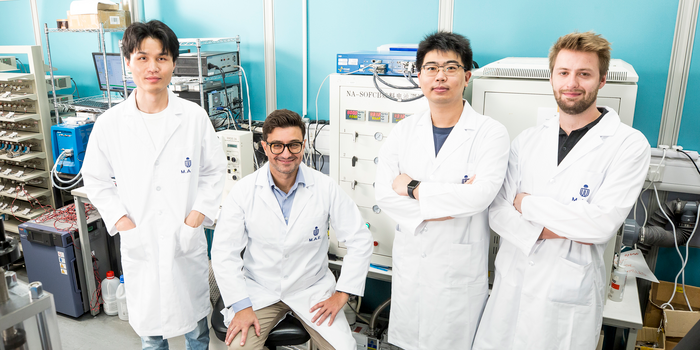Reviewed by Alex SmithNov 17 2022
At the Hong Kong University of Science and Technology (HKUST), scientists have fabricated an innovative iron-based cathode material to obtain record performance for protonic ceramic fuel cells.
 Prof. Francesco Ciucci (second left), postdoctoral fellow Dr. Song Yufei (first left), PhD students Wang Yuhao (second right), and Matthew James Robson (first right) and other team members have identified an exceptionally promising cathode material for protonic ceramic fuel cells, marking a major step toward the commercialization of this renewable energy technology. Image credits: Hong Kong University of Science and Technology
Prof. Francesco Ciucci (second left), postdoctoral fellow Dr. Song Yufei (first left), PhD students Wang Yuhao (second right), and Matthew James Robson (first right) and other team members have identified an exceptionally promising cathode material for protonic ceramic fuel cells, marking a major step toward the commercialization of this renewable energy technology. Image credits: Hong Kong University of Science and Technology
This marks a considerable step ahead in developing and commercializing this encouraging renewable energy technology.
Fuel cells, which tend to use the chemical energy of hydrogen or other fuels to produce electricity in a clecleanly and efficientlyo-friendly power sources that have come under intensive development throughout the world to fight energy shortage and climate change.
A novel technology has been raised in the field, known as protonic ceramic fuel cells (PCFCs), that are based on proton-conducting ceramic electrolytes. Also, they have the benefits of high efficiency, low pollutant emissions, and the adaptability to function well with not just hydrogen but also other gases like methane, biogas, and ammonia. Generally, they are utilized for distributed power generation, such as off-grid power production.
But the extensive commercialization of PCFCs has been impeded by the need for more affordable cathode materials and high performance.
At present, cobalt-based perovskites are known to be the most extensively utilized cathode materials, as cobalt has the potential to decrease and increase its oxidation number easily. This leads to an excellent oxygen reduction reaction activity that seems crucial to the cathode’s performance.
But these materials come with expensive costs, cause pollution in mining, and need complicated preparation procedures that are inconsistent with mass production. Also, they are in huge demand for lithium-ion batteries, generally utilized in electric vehicles.
Preferably, cobalt requires substituting by transition metals with reduced costs but similar reactivity. Iron comes close to cobalt in the periodic table and shares several similar chemical properties, but it is budget-friendly.
Moreover, iron-based materials are normally known to be worse catalysts, thus resulting in inadequate performance. Hence, the compositions of the materials should be fine-tuned to determine the best-performing material.
Heading in this direction, a research group headed by Professor Francesco Ciucci from the Department of Mechanical & Aerospace Engineering and Department of Chemical & Biological Engineering integrated molecular orbital analysis, first-principle simulations, and experiments.
This was done to devise new, cheap ceramics that make use of low-cost elements, like barium (Ba), zirconium (Zr), and iron (Fe), resulting in a PCFC with record performance.
The research group developed the cathode materials from fundamental physical-chemical principles and density functional theory. With the help of computationally guided optimization, Ba0.875Fe0.875Zr0.125O3-δ (D-BFZ) was determined as the most encouraging cathode material.
Hence, experiments showed that D-BFZ exhibited an unusual electrochemical activity to react with oxygen, obtaining a high peak power density, among the best in the field, and outstanding operational stability.
Furthermore, D-BFZ could be produced by using a simple and mass-production-suitable synthesis method. This is a significant step toward identifying PCFCs that are commercially feasible.
PCFC technology could be transformational and there are many exciting opportunities to develop it further. We will continue to leverage first-principle calculations and experiments to improve the performance of PCFCs.
Francesco Ciucci, Professor, Department of Mechanical & Aerospace Engineering, The Hong Kong University of Science and Technology
Ciucci added, “If used reversibly, PCFCs will have a tremendous impact on hard-to-decarbonize sectors, such as siderurgy, ammonia production, and heavy-duty transportation.”
Headed by Professor Ciucci, the research group included PhD students Yuhao Wang, Matthew James ROBSON, and Alessio BELOTTI; postdoctoral fellow Dr. Yufei Song; PhD graduates Dr. WANG Jian (Class of 2018) and Dr. LIU Jiapeng (Class of 2020); former postdoctoral fellows Dr. WANG Zheng and Dr. ZHANG Zhiqi; and also collaborators from Ulsan National Institute of Science and Technology and Seoul National University in South Korea, Nanjing Tech University in China, and Curtin University in Australia.
Journal Reference:
Wang, Z., et al. (2022) Rational design of perovskite ferrites as high-performance proton-conducting fuel cell cathodes. Nature catalysis. doi.org/10.1038/s41929-022-00829-9.